| Cambrian | ||||||||||||||||||||||||||||||||||||||
|---|---|---|---|---|---|---|---|---|---|---|---|---|---|---|---|---|---|---|---|---|---|---|---|---|---|---|---|---|---|---|---|---|---|---|---|---|---|---|
 Earth in the middle of the Cambrian Period, c. 510 Ma | ||||||||||||||||||||||||||||||||||||||
| Chronology | ||||||||||||||||||||||||||||||||||||||
| ||||||||||||||||||||||||||||||||||||||
| Etymology | ||||||||||||||||||||||||||||||||||||||
| Name formality | Formal | |||||||||||||||||||||||||||||||||||||
| Usage information | ||||||||||||||||||||||||||||||||||||||
| Celestial body | Earth | |||||||||||||||||||||||||||||||||||||
| Regional usage | Global (ICS) | |||||||||||||||||||||||||||||||||||||
| Time scale(s) used | ICS Time Scale | |||||||||||||||||||||||||||||||||||||
| Definition | ||||||||||||||||||||||||||||||||||||||
| Chronological unit | Period | |||||||||||||||||||||||||||||||||||||
| Stratigraphic unit | System | |||||||||||||||||||||||||||||||||||||
| First proposed by | Adam Sedgwick, 1835 | |||||||||||||||||||||||||||||||||||||
| Time span formality | Formal | |||||||||||||||||||||||||||||||||||||
| Lower boundary definition | Appearance of the Ichnofossil Treptichnus pedum | |||||||||||||||||||||||||||||||||||||
| Lower boundary GSSP | Fortune Head section, Newfoundland, Canada 47°04′34″N 55°49′52″W / 47.0762°N 55.8310°W | |||||||||||||||||||||||||||||||||||||
| Lower GSSP ratified | 1992[2] | |||||||||||||||||||||||||||||||||||||
| Upper boundary definition | FAD of the Conodont Iapetognathus fluctivagus. | |||||||||||||||||||||||||||||||||||||
| Upper boundary GSSP | Greenpoint section, Green Point, Newfoundland, Canada 49°40′58″N 57°57′55″W / 49.6829°N 57.9653°W | |||||||||||||||||||||||||||||||||||||
| Upper GSSP ratified | 2000[3] | |||||||||||||||||||||||||||||||||||||
| Atmospheric and climatic data | ||||||||||||||||||||||||||||||||||||||
| Sea level above present day | Rising steadily from 4 m to 90 m[4] | |||||||||||||||||||||||||||||||||||||
The Cambrian Period ( /ˈkæmbri.ən, ˈkeɪm-/ KAM-bree-ən, KAYM-; sometimes symbolized Ꞓ) is the first geological period of the Paleozoic Era, and of the Phanerozoic Eon.[5] The Cambrian lasted 53.4 million years from the end of the preceding Ediacaran Period 538.8 million years ago (mya) to the beginning of the Ordovician Period 485.4 mya.[6] Its subdivisions, and its base, are somewhat in flux.
The period was established as "Cambrian series" by Adam Sedgwick,[5] who named it after Cambria, the Latin name for 'Cymru' (Wales), where Britain's Cambrian rocks are best exposed.[7][8][9] Sedgwick identified the layer as part of his task, along with Roderick Murchison, to subdivide the large "Transition Series", although the two geologists disagreed for a while on the appropriate categorization.[5]
The Cambrian is unique in its unusually high proportion of lagerstätte sedimentary deposits, sites of exceptional preservation where "soft" parts of organisms are preserved as well as their more resistant shells. As a result, scientific understanding of the Cambrian biology surpasses that of some later periods.[10]
The Cambrian marked a profound change in life on Earth: prior to the Cambrian, the majority of living organisms on the whole were small, unicellular and simple (Ediacaran fauna and earlier Tonian Huainan biota being notable exceptions). Complex, multicellular organisms gradually became more common in the millions of years immediately preceding the Cambrian, but it was not until this period that mineralized – hence readily fossilized – organisms became common.[11]
The rapid diversification of lifeforms in the Cambrian, known as the Cambrian explosion, produced the first representatives of most modern animal phyla. Phylogenetic analysis has supported the view that before the Cambrian radiation, in the Cryogenian[12][13][14] or Tonian,[15] animals (metazoans) evolved monophyletically from a single common ancestor: flagellated colonial protists similar to modern choanoflagellates.[16] Although diverse life forms prospered in the oceans, the land is thought to have been comparatively barren – with nothing more complex than a microbial soil crust[17] and a few molluscs and arthropods (albeit not terrestrial) that emerged to browse on the microbial biofilm.[18]
By the end of the Cambrian, myriapods,[19][20] arachnids,[21] and hexapods[22] started adapting to the land, along with the first plants.[23][24] Most of the continents were probably dry and rocky due to a lack of vegetation. Shallow seas flanked the margins of several continents created during the breakup of the supercontinent Pannotia. The seas were relatively warm, and polar ice was absent for much of the period.
Stratigraphy
The Cambrian Period followed the Ediacaran Period and was followed by the Ordovician Period.
The base of the Cambrian lies atop a complex assemblage of trace fossils known as the Treptichnus pedum assemblage.[25] The use of Treptichnus pedum, a reference ichnofossil to mark the lower boundary of the Cambrian, is problematic because very similar trace fossils belonging to the Treptichnids group are found well below T. pedum in Namibia, Spain, Newfoundland, and possibly in the western US. The stratigraphic range of T. pedum overlaps the range of the Ediacaran fossils in Namibia, and probably in Spain.[26][27]
Subdivisions
The Cambrian is divided into four epochs (series) and ten ages (stages). Currently only three series and six stages are named and have a GSSP (an internationally agreed-upon stratigraphic reference point).
Because the international stratigraphic subdivision is not yet complete, many local subdivisions are still widely used. In some of these subdivisions the Cambrian is divided into three epochs with locally differing names – the Early Cambrian (Caerfai or Waucoban, 538.8 ± 0.2 to 509 ± 1.9 mya), Middle Cambrian (St Davids or Albertan, 509 ± 0.2 to 497 ± 1.9 mya) and Late Cambrian (497 ± 0.2 to 485.4 ± 1.9 mya; also known as Merioneth or Croixan). Trilobite zones allow biostratigraphic correlation in the Cambrian. Rocks of these epochs are referred to as belonging to the Lower, Middle, or Upper Cambrian.
Each of the local series is divided into several stages. The Cambrian is divided into several regional faunal stages of which the Russian-Kazakhian system is most used in international parlance:
| International Series | International Stage | Chinese | Australian | Russian-Kazakhian | North American | European | |
|---|---|---|---|---|---|---|---|
| C a m b r i a n |
Furongian | "Stage 10" | Niuchehean | Datsonian | Batyrbaian | Skullrockian / Ibexian (part) | Merionethian |
| Payntonian | Sunwaptan / Trempealeauan | ||||||
| Jiangshanian | Jiangshanian | Iverian | Aksaian | ||||
| Sakian | |||||||
| Paibian | Paibian | Idamean | Steptoean / Franconian | ||||
| Miaolingian | Guzhangian | Guzhangian | Mindyallan | Ayusokkanian | Marjuman / Dresbachian | ||
| Boomerangian | Mayan | Acadian / St. David's | |||||
| Drumian | Wangcunian | Undillian | |||||
| Florian | |||||||
| Wuliuan | Wuliuan | Templetonian | Amgan / Amgaian | Topazan | |||
| Ordian | Delmaran | ||||||
| Cambrian Series 2 | "Stage 4" | Duyunian | Branchian / Comley (part) | ||||
| Toyonian | |||||||
| Dyeran | |||||||
| Botomian | |||||||
| "Stage 3" | Nangaoan | ||||||
| Atdabanian | Montezuman | ||||||
| Placentian / Comley (part) | |||||||
| Terreneuvian | "Stage 2" | Meishucunian | Tommotian* | Begadean | |||
| Jinningian | Nemakit-Daldynian* | ||||||
| Fortunian | |||||||
| Ediacaran | Sinian | Adelaidean | Sakharan / Vendian | Hadrynian | |||
| Part of a series on |
| The Cambrian explosion |
|---|
 |
*Most Russian paleontologists define the lower boundary of the Cambrian at the base of the Tommotian Stage, characterized by diversification and global distribution of organisms with mineral skeletons and the appearance of the first Archaeocyath bioherms.[29][30][31]
Dating the Cambrian

The International Commission on Stratigraphy lists the Cambrian Period as beginning at 538.8 million years ago and ending at 485.4 million years ago.
The lower boundary of the Cambrian was originally held to represent the first appearance of complex life, represented by trilobites. The recognition of small shelly fossils before the first trilobites, and Ediacara biota substantially earlier, led to calls for a more precisely defined base to the Cambrian Period.[32]
Despite the long recognition of its distinction from younger Ordovician rocks and older Precambrian rocks, it was not until 1994 that the Cambrian system/period was internationally ratified. After decades of careful consideration, a continuous sedimentary sequence at Fortune Head, Newfoundland was settled upon as a formal base of the Cambrian Period, which was to be correlated worldwide by the earliest appearance of Treptichnus pedum.[32] Discovery of this fossil a few metres below the GSSP led to the refinement of this statement, and it is the T. pedum ichnofossil assemblage that is now formally used to correlate the base of the Cambrian.[32][33]
This formal designation allowed radiometric dates to be obtained from samples across the globe that corresponded to the base of the Cambrian. Early dates of 570 million years ago quickly gained favour,[32] though the methods used to obtain this number are now considered to be unsuitable and inaccurate. A more precise date using modern radiometric dating yield a date of 538.8 ± 0.2 million years ago.[6] The ash horizon in Oman from which this date was recovered corresponds to a marked fall in the abundance of carbon-13 that correlates to equivalent excursions elsewhere in the world, and to the disappearance of distinctive Ediacaran fossils (Namacalathus, Cloudina). Nevertheless, there are arguments that the dated horizon in Oman does not correspond to the Ediacaran-Cambrian boundary, but represents a facies change from marine to evaporite-dominated strata – which would mean that dates from other sections, ranging from 544 or 542 Ma, are more suitable.[32]
Paleogeography
Plate reconstructions suggest a global supercontinent, Pannotia, was in the process of breaking up early in the Cambrian,[34][35] with Laurentia (North America), Baltica, and Siberia having separated from the main supercontinent of Gondwana to form isolated land masses.[36] Most continental land was clustered in the Southern Hemisphere at this time, but was drifting north.[36] Large, high-velocity rotational movement of Gondwana appears to have occurred in the Early Cambrian.[37]
With a lack of sea ice – the great glaciers of the Marinoan Snowball Earth were long melted[38] – the sea level was high, which led to large areas of the continents being flooded in warm, shallow seas ideal for sea life. The sea levels fluctuated somewhat, suggesting there were "ice ages", associated with pulses of expansion and contraction of a south polar ice cap.[39]
In Baltoscandia a Lower Cambrian transgression transformed large swathes of the Sub-Cambrian peneplain into an epicontinental sea.[40]
Climate
Glaciers likely existed during the earliest Cambrian at high and possibly even at middle palaeolatitudes,[41] possibly due to the ancient continent of Gondwana covering the South Pole and cutting off polar ocean currents. Middle Terreneuvian deposits, corresponding to the boundary between the Fortunian and Stage 2, show evidence of glaciation.[42] However, other authors believe these very early, pretrilobitic glacial deposits may not even be of Cambrian age at all but instead date back to the Neoproterozoic, an era characterised by numerous severe icehouse periods.[43]
The beginning of Stage 3 was relatively cool, with the period between 521 and 517 Ma being known as the Cambrian Arthropod Radiation Cool Event (CARCE).[44] The Earth was generally very warm during Stage 4; its climate was comparable to the hot greenhouse of the Late Cretaceous and Early Palaeogene, as evidenced by a maximum in continental weathering rates over the last 900 million years and the presence of tropical, lateritic palaeosols at high palaeolatitudes during this time.[43]
The Archaecyathid Extinction Warm Event (AEWE), lasting from 511 to 510.5 Ma, was particularly warm. Another warm event, the Redlichiid-Olenid Extinction Warm Event, occurred at the beginning of the Wuliuan.[44] It became even warmer towards the end of the period, and sea levels rose dramatically. This warming trend continued into the Early Ordovician, the start of which was characterised by an extremely hot global climate.[45]
Flora
The Cambrian flora was little different from the Ediacaran. The principal taxa were the marine macroalgae Fuxianospira, Sinocylindra, and Marpolia. No calcareous macroalgae are known from the period.[46]
No land plant (embryophyte) fossils are known from the Cambrian. However, biofilms and microbial mats were well developed on Cambrian tidal flats and beaches 500 mya,[17] and microbes forming microbial Earth ecosystems, comparable with modern soil crust of desert regions, contributing to soil formation.[47][48] Although molecular clock estimates suggest terrestrial plants may have first emerged during the Middle or Late Cambrian, the consequent large-scale removal of the greenhouse gas CO2 from the atmosphere through sequestration did not begin until the Ordovician.[49]
Oceanic life
−4500 — – — – −4000 — – — – −3500 — – — – −3000 — – — – −2500 — – — – −2000 — – — – −1500 — – — – −1000 — – — – −500 — – — – 0 — |
| |||||||||||||||||||||||||||||||||||||||||||||
The Cambrian explosion was a period of rapid multicellular growth. Most animal life during the Cambrian was aquatic. Trilobites were once assumed to be the dominant life form at that time,[50] but this has proven to be incorrect. Arthropods were by far the most dominant animals in the ocean, but trilobites were only a minor part of the total arthropod diversity. What made them so apparently abundant was their heavy armor reinforced by calcium carbonate (CaCO3), which fossilized far more easily than the fragile chitinous exoskeletons of other arthropods, leaving numerous preserved remains.[51]
The period marked a steep change in the diversity and composition of Earth's biosphere. The Ediacaran biota suffered a mass extinction at the start of the Cambrian Period, which corresponded with an increase in the abundance and complexity of burrowing behaviour. This behaviour had a profound and irreversible effect on the substrate which transformed the seabed ecosystems. Before the Cambrian, the sea floor was covered by microbial mats. By the end of the Cambrian, burrowing animals had destroyed the mats in many areas through bioturbation. As a consequence, many of those organisms that were dependent on the mats became extinct, while the other species adapted to the changed environment that now offered new ecological niches.[52] Around the same time there was a seemingly rapid appearance of representatives of all the mineralized phyla, including the Bryozoa,[53] which were once thought to have only appeared in the Lower Ordovician.[54] However, many of those phyla were represented only by stem-group forms; and since mineralized phyla generally have a benthic origin, they may not be a good proxy for (more abundant) non-mineralized phyla.[55]
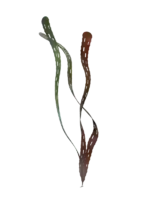
While the early Cambrian showed such diversification that it has been named the Cambrian Explosion, this changed later in the period, when there occurred a sharp drop in biodiversity. About 515 million years ago, the number of species going extinct exceeded the number of new species appearing. Five million years later, the number of genera had dropped from an earlier peak of about 600 to just 450. Also, the speciation rate in many groups was reduced to between a fifth and a third of previous levels. 500 million years ago, oxygen levels fell dramatically in the oceans, leading to hypoxia, while the level of poisonous hydrogen sulfide simultaneously increased, causing another extinction. The later half of Cambrian was surprisingly barren and showed evidence of several rapid extinction events; the stromatolites which had been replaced by reef building sponges known as Archaeocyatha, returned once more as the archaeocyathids became extinct. This declining trend did not change until the Great Ordovician Biodiversification Event.[57][58]
Some Cambrian organisms ventured onto land, producing the trace fossils Protichnites and Climactichnites. Fossil evidence suggests that euthycarcinoids, an extinct group of arthropods, produced at least some of the Protichnites.[59] Fossils of the track-maker of Climactichnites have not been found; however, fossil trackways and resting traces suggest a large, slug-like mollusc.[60]
In contrast to later periods, the Cambrian fauna was somewhat restricted; free-floating organisms were rare, with the majority living on or close to the sea floor;[61] and mineralizing animals were rarer than in future periods, in part due to the unfavourable ocean chemistry.[61]
Many modes of preservation are unique to the Cambrian, and some preserve soft body parts, resulting in an abundance of Lagerstätten. These include Sirius Passet,[62][63] the Sinsk Algal Lens,[64] the Maotianshan Shales,[65] the Emu Bay Shale,[66] and the Burgess Shale,[67][68][69].
Symbol
The United States Federal Geographic Data Committee uses a "barred capital C" ⟨Ꞓ⟩ character to represent the Cambrian Period.[70] The Unicode character is U+A792 Ꞓ LATIN CAPITAL LETTER C WITH BAR.[71][72]
Gallery
 Stromatolites of the Pika Formation (Middle Cambrian) near Helen Lake, Banff National Park, Canada
Stromatolites of the Pika Formation (Middle Cambrian) near Helen Lake, Banff National Park, Canada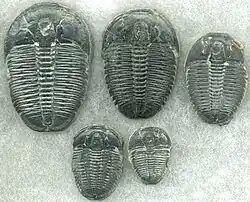 Trilobites, like these Elrathia kingii were very common arthropods during this time
Trilobites, like these Elrathia kingii were very common arthropods during this time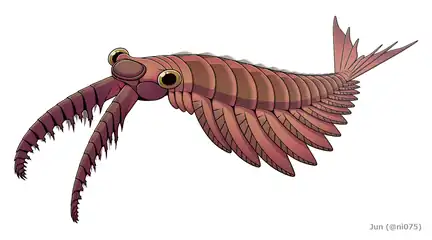 Anomalocaris was an early marine predator, a member of the stem-arthropod group Radiodonta
Anomalocaris was an early marine predator, a member of the stem-arthropod group Radiodonta Opabinia was a bizarre stem-arthropod that possessed five stalked eyes, and a fused proboscis tipped with a claw-like appendage.
Opabinia was a bizarre stem-arthropod that possessed five stalked eyes, and a fused proboscis tipped with a claw-like appendage.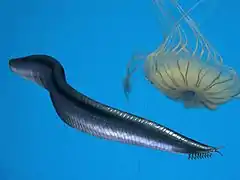 Pikaia was a stem-chordate from the Middle Cambrian
Pikaia was a stem-chordate from the Middle Cambrian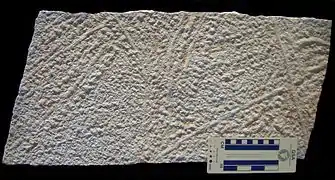 Protichnites were the trackways of arthropods that walked Cambrian beaches
Protichnites were the trackways of arthropods that walked Cambrian beaches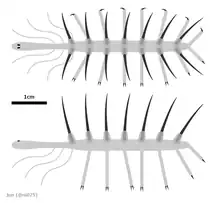 Hallucigenia sparsa was a member of group lobopodian, that is considered to related to be modern velvet worms.
Hallucigenia sparsa was a member of group lobopodian, that is considered to related to be modern velvet worms.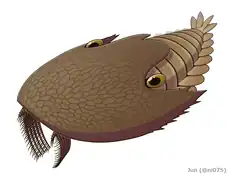 Cambroraster falcatus was a hurdiid radiodont that bore a large horseshoe-shaped carapace.
Cambroraster falcatus was a hurdiid radiodont that bore a large horseshoe-shaped carapace.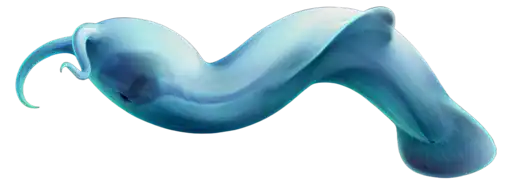 Amiskwia sagittiformis was a large bodied gnathiferan from Canada and China
Amiskwia sagittiformis was a large bodied gnathiferan from Canada and China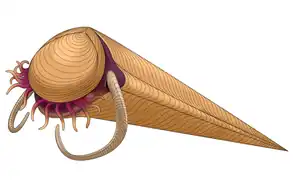 Haplophrentis was a hyolith, a group of conical shelled lophotrochozoans that were potentially related to either lophophorates or mollusks.
Haplophrentis was a hyolith, a group of conical shelled lophotrochozoans that were potentially related to either lophophorates or mollusks.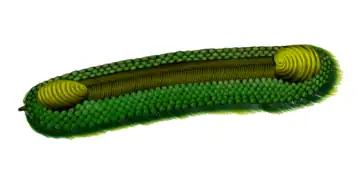 Halkieria was a bizarre invertebrate that was an early member of the mollusk group
Halkieria was a bizarre invertebrate that was an early member of the mollusk group
See also
- Cambrian–Ordovician extinction event – circa 488 mya
- Dresbachian extinction event—circa 499 mya
- End Botomian extinction event—circa 513 mya
- List of fossil sites (with link directory)
- Type locality (geology), the locality where a particular rock type, stratigraphic unit, fossil or mineral species is first identified
References
- ↑ "Chart/Time Scale". stratigraphy.org. International Commission on Stratigraphy.
- ↑ Brasier, Martin; Cowie, John; Taylor, Michael (March–June 1994). "Decision on the Precambrian-Cambrian boundary stratotype" (PDF). Episodes. 17. Archived (PDF) from the original on 9 October 2022.
- ↑ Cooper, Roger; Nowlan, Godfrey; Williams, S. H. (March 2001). "Global Stratotype Section and Point for base of the Ordovician System" (PDF). Episodes. 24 (1): 19–28. doi:10.18814/epiiugs/2001/v24i1/005. Archived (PDF) from the original on 9 October 2022. Retrieved 6 December 2020.
- ↑ Haq, B. U.; Schutter, SR (2008). "A Chronology of Paleozoic Sea-Level Changes". Science. 322 (5898): 64–8. Bibcode:2008Sci...322...64H. doi:10.1126/science.1161648. PMID 18832639. S2CID 206514545.
- 1 2 3 Howe 1911, p. 86.
- 1 2 "International Stratigraphic Chart" (PDF). International Commission on Stratigraphy. June 2023. Archived (PDF) from the original on 13 July 2023. Retrieved 19 July 2023.
- ↑ Sedgwick and R. I. Murchison (1835) "On the Silurian and Cambrian systems, exhibiting the order in which the older sedimentary strata succeed each other in England and Wales," Notices and Abstracts of Communications to the British Association for the Advancement of Science at the Dublin meeting, August 1835, pp. 59–61, in: Report of the Fifth Meeting of the British Association for the Advancement of Science; held in Dublin in 1835 (1836). From p. 60: "Professor Sedgwick then described in descending order the groups of slate rocks, as they are seen in Wales and Cumberland. To the highest he gave the name of Upper Cambrian group. ... To the next inferior group he gave the name of Middle Cambrian. ... The Lower Cambrian group occupies the S.W. coast of Cærnarvonshire,"
- ↑ Sedgwick, A. (1852). "On the classification and nomenclature of the Lower Paleozoic rocks of England and Wales". Q. J. Geol. Soc. Lond. 8 (1–2): 136–138. doi:10.1144/GSL.JGS.1852.008.01-02.20. S2CID 130896939.
- ↑ Chambers 21st Century Dictionary. Chambers Dictionary (Revised ed.). New Delhi: Allied Publishers. 2008. p. 203. ISBN 978-81-8424-329-1.
- ↑ Orr, P. J.; Benton, M. J.; Briggs, D. E. G. (2003). "Post-Cambrian closure of the deep-water slope-basin taphonomic window". Geology. 31 (9): 769–772. Bibcode:2003Geo....31..769O. doi:10.1130/G19193.1.
- ↑ Butterfield, N. J. (2007). "Macroevolution and macroecology through deep time". Palaeontology. 50 (1): 41–55. Bibcode:2007Palgy..50...41B. doi:10.1111/j.1475-4983.2006.00613.x.
- ↑ Love; Grosjean, Emmanuelle; Stalvies, Charlotte; Fike, David A.; Grotzinger, John P.; Bradley, Alexander S.; Kelly, Amy E.; Bhatia, Maya; Meredith, William; et al. (2009). "Fossil steroids record the appearance of Demospongiae during the Cryogenian period" (PDF). Nature. 457 (7230): 718–721. Bibcode:2009Natur.457..718L. doi:10.1038/nature07673. PMID 19194449. S2CID 4314662. Archived from the original (PDF) on 8 May 2018. Retrieved 7 December 2021.
- ↑ Maloof, Adam C.; Rose, Catherine V.; Beach, Robert; Samuels, Bradley M.; Calmet, Claire C.; Erwin, Douglas H.; Poirier, Gerald R.; Yao, Nan; Simons, Frederik J. (17 August 2010). "Possible animal-body fossils in pre-Marinoan limestones from South Australia". Nature Geoscience. 3 (9): 653–659. Bibcode:2010NatGe...3..653M. doi:10.1038/ngeo934.
- ↑ "Discovery of possible earliest animal life pushes back fossil record". 17 August 2010.
- ↑ Kliman, Richard M. (14 April 2016). Encyclopedia of Evolutionary Biology. Academic Press. p. 251. ISBN 9780128004265.
- ↑ Carr M, Leadbeater BS, Hassan R, Nelson M, Baldauf SL (October 2008). "Molecular phylogeny of choanoflagellates, the sister group to Metazoa". Proceedings of the National Academy of Sciences of the United States of America. 105 (43): 16641–6. Bibcode:2008PNAS..10516641C. doi:10.1073/pnas.0801667105. PMC 2575473. PMID 18922774.
- 1 2 Schieber et al. 2007, pp. 53–71.
- ↑ Seilacher, A.; Hagadorn, J.W. (2010). "Early Molluscan evolution: evidence from the trace fossil-record" (PDF). PALAIOS (Submitted manuscript). 25 (9): 565–575. Bibcode:2010Palai..25..565S. doi:10.2110/palo.2009.p09-079r. S2CID 129360547. Archived (PDF) from the original on 9 October 2022.
- ↑ Collette, Gass & Hagadorn 2012.
- ↑ Edgecombe, Gregory D.; Strullu-Derrien, Christine; Góral, Tomasz; Hetherington, Alexander J.; Thompson, Christine; Koch, Marcus (2020). "Aquatic stem group myriapods close a gap between molecular divergence dates and terrestrial fossil record". Proceedings of the National Academy of Sciences. 117 (16): 8966–8972. Bibcode:2020PNAS..117.8966E. doi:10.1073/pnas.1920733117. PMC 7183169. PMID 32253305. S2CID 215408474.
- ↑ Lozano-Fernandez, Jesus; Tanner, Alastair R.; Puttick, Mark N.; Vinther, Jakob; Edgecombe, Gregory D.; Pisani, Davide (2020). "A Cambrian–Ordovician Terrestrialization of Arachnids". Frontiers in Genetics. 11: 182. doi:10.3389/fgene.2020.00182. PMC 7078165. PMID 32218802.
- ↑ Lozano-Fernandez, Jesus; Carton, Robert; Tanner, Alastair R.; Puttick, Mark N.; Blaxter, Mark; Vinther, Jakob; Olesen, Jørgen; Giribet, Gonzalo; Edgecombe, Gregory D.; Pisani, Davide (2016). "A molecular palaeobiological exploration of arthropod terrestrialization". Philosophical Transactions of the Royal Society B: Biological Sciences. 371 (1699). doi:10.1098/rstb.2015.0133. PMC 4920334. PMID 27325830.
- ↑ De Vries, Jan; De Vries, Sophie; Fürst-Jansen, Janine M R. (2020). "Evo-physio: On stress responses and the earliest land plants". Journal of Experimental Botany. 71 (11): 3254–3269. doi:10.1093/jxb/eraa007. PMC 7289718. PMID 31922568.
- ↑ Morris, Jennifer L.; Puttick, Mark N.; Clark, James W.; Edwards, Dianne; Kenrick, Paul; Pressel, Silvia; Wellman, Charles H.; Yang, Ziheng; Schneider, Harald; Donoghue, Philip C. J. (2018). "The timescale of early land plant evolution". Proceedings of the National Academy of Sciences. 115 (10): E2274–E2283. Bibcode:2018PNAS..115E2274M. doi:10.1073/pnas.1719588115. PMC 5877938. PMID 29463716.
- ↑ A. Knoll, M. Walter, G. Narbonne, and N. Christie-Blick (2004) "The Ediacaran Period: A New Addition to the Geologic Time Scale." Submitted on Behalf of the Terminal Proterozoic Subcommission of the International Commission on Stratigraphy.
- ↑ M.A. Fedonkin, B.S. Sokolov, M.A. Semikhatov, N.M.Chumakov (2007). "Vendian versus Ediacaran: priorities, contents, prospectives. Archived 4 October 2011 at the Wayback Machine" In: edited by M. A. Semikhatov "The Rise and Fall of the Vendian (Ediacaran) Biota. Origin of the Modern Biosphere. Transactions of the International Conference on the IGCP Project 493, August 20–31, 2007, Moscow. Archived 22 November 2012 at the Wayback Machine" Moscow: GEOS.
- ↑ A. Ragozina, D. Dorjnamjaa, A. Krayushkin, E. Serezhnikova (2008). "Treptichnus pedum and the Vendian-Cambrian boundary Archived 4 October 2011 at the Wayback Machine". 33 Intern. Geol. Congr. 6–14 August 2008, Oslo, Norway. Abstracts. Section HPF 07 Rise and fall of the Ediacaran (Vendian) biota. p. 183.
- ↑ Peng, S.C.; Babcock, L.E.; Ahlberg, P. (2020), "The Cambrian Period", Geologic Time Scale 2020, Elsevier, pp. 565–629, doi:10.1016/b978-0-12-824360-2.00019-x, ISBN 978-0-12-824360-2, S2CID 242177216, retrieved 8 June 2023
- ↑ A.Yu. Rozanov; V.V. Khomentovsky; Yu.Ya. Shabanov; G.A. Karlova; A.I. Varlamov; V.A. Luchinina; T.V. Pegel'; Yu.E. Demidenko; P.Yu. Parkhaev; I.V. Korovnikov; N.A. Skorlotova (2008). "To the problem of stage subdivision of the Lower Cambrian". Stratigraphy and Geological Correlation. 16 (1): 1–19. Bibcode:2008SGC....16....1R. doi:10.1007/s11506-008-1001-3. S2CID 128128572.
- ↑ B. S. Sokolov; M. A. Fedonkin (1984). "The Vendian as the Terminal System of the Precambrian" (PDF). Episodes. 7 (1): 12–20. doi:10.18814/epiiugs/1984/v7i1/004. Archived from the original (PDF) on 25 March 2009.
- ↑ V. V. Khomentovskii; G. A. Karlova (2005). "The Tommotian Stage Base as the Cambrian Lower Boundary in Siberia". Stratigraphy and Geological Correlation. 13 (1): 21–34. Archived from the original on 14 July 2011. Retrieved 15 March 2009.
- 1 2 3 4 5 Geyer, Gerd; Landing, Ed (2016). "The Precambrian–Phanerozoic and Ediacaran–Cambrian boundaries: A historical approach to a dilemma". Geological Society, London, Special Publications. 448 (1): 311–349. Bibcode:2017GSLSP.448..311G. doi:10.1144/SP448.10. S2CID 133538050.
- ↑ Landing, Ed; Geyer, Gerd; Brasier, Martin D.; Bowring, Samuel A. (2013). "Cambrian Evolutionary Radiation: Context, correlation, and chronostratigraphy—Overcoming deficiencies of the first appearance datum (FAD) concept". Earth-Science Reviews. 123: 133–172. Bibcode:2013ESRv..123..133L. doi:10.1016/j.earscirev.2013.03.008.
- ↑ Powell, C.M.; Dalziel, I.W.D.; Li, Z.X.; McElhinny, M.W. (1995). "Did Pannotia, the latest Neoproterozoic southern supercontinent, really exist". Eos, Transactions, American Geophysical Union. 76: 46–72.
- ↑ Scotese, C.R. (1998). "A tale of two supercontinents: the assembly of Rodinia, its break-up, and the formation of Pannotia during the Pan-African event". Journal of African Earth Sciences. 27 (1A): 1–227. Bibcode:1998JAfES..27....1A. doi:10.1016/S0899-5362(98)00028-1.
- 1 2 Mckerrow, W. S.; Scotese, C. R.; Brasier, M. D. (1992). "Early Cambrian continental reconstructions". Journal of the Geological Society. 149 (4): 599–606. Bibcode:1992JGSoc.149..599M. doi:10.1144/gsjgs.149.4.0599. S2CID 129389099.
- ↑ Mitchell, R. N.; Evans, D. A. D.; Kilian, T. M. (2010). "Rapid Early Cambrian rotation of Gondwana". Geology. 38 (8): 755. Bibcode:2010Geo....38..755M. doi:10.1130/G30910.1.
- ↑ Smith, Alan G. (2009). "Neoproterozoic timescales and stratigraphy". Geological Society, London, Special Publications. 326 (1): 27–54. Bibcode:2009GSLSP.326...27S. doi:10.1144/SP326.2. S2CID 129706604.
- ↑ Brett, C. E.; Allison, P. A.; Desantis, M. K.; Liddell, W. D.; Kramer, A. (2009). "Sequence stratigraphy, cyclic facies, and lagerstätten in the Middle Cambrian Wheeler and Marjum Formations, Great Basin, Utah". Palaeogeography, Palaeoclimatology, Palaeoecology. 277 (1–2): 9–33. Bibcode:2009PPP...277....9B. doi:10.1016/j.palaeo.2009.02.010.
- ↑ Nielsen, Arne Thorshøj; Schovsbo, Niels Hemmingsen (2011). "The Lower Cambrian of Scandinavia: Depositional environment, sequence stratigraphy and palaeogeography". Earth-Science Reviews. 107 (3–4): 207–310. Bibcode:2011ESRv..107..207N. doi:10.1016/j.earscirev.2010.12.004.
- ↑ Wang, Yuchong; Kuang, Hongwei; Liu, Yongqing; Chen, Xiaoshuai; Zhao, Fenghua; Le Heron, Daniel Paul; Vandyk, Thomas Matthew; Peng, Nan; Yang, Zhenrui; Bai, Huaqing (November 2022). "Composite sand-ice wedge pseudomorphs suggestive of a frosty Ediacaran–Cambrian transition". Precambrian Research. 382: 106873. Bibcode:2022PreR..382j6873W. doi:10.1016/j.precamres.2022.106873. S2CID 253072999. Retrieved 17 December 2022.
- ↑ Landing, Ed; MacGabhann, Breandán Anraoi (15 January 2010). "First evidence for Cambrian glaciation provided by sections in Avalonian New Brunswick and Ireland: Additional data for Avalon–Gondwana separation by the earliest Palaeozoic". Palaeogeography, Palaeoclimatology, Palaeoecology. 285 (3–4): 174–185. Bibcode:2010PPP...285..174L. doi:10.1016/j.palaeo.2009.11.009. Retrieved 17 December 2022.
- 1 2 Hearing, Thomas W.; Harvey, Thomas H. P.; Williams, Mark; Leng, Melanie J.; Lamb, Angela L.; Wilby, Philip R.; Gabbott, Sarah E.; Pohl, Alexandre; Donnadieu, Yannick (9 May 2018). "An early Cambrian greenhouse climate". Science Advances. 4 (5): eaar5690. Bibcode:2018SciA....4.5690H. doi:10.1126/sciadv.aar5690. PMC 5942912. PMID 29750198.
- 1 2 Scotese, Christopher R.; Song, Haijun; Mills, Benjamin J.W.; van der Meer, Douwe G. (April 2021). "Phanerozoic paleotemperatures: The earth's changing climate during the last 540 million years". Earth-Science Reviews. 215: 103503. Bibcode:2021ESRv..21503503S. doi:10.1016/j.earscirev.2021.103503. ISSN 0012-8252. S2CID 233579194. Archived from the original on 8 January 2021. Alt URL
- ↑ Goldberg, Samuel L.; Present, Theodore M.; Finnegan, Seth; Bergmann, Kristin D. (9 February 2021). "A high-resolution record of early Paleozoic climate". Proceedings of the National Academy of Sciences of the United States of America. 118 (6): e2013083118. Bibcode:2021PNAS..11813083G. doi:10.1073/pnas.2013083118. PMC 8017688. PMID 33526667.
- ↑ LoDuca, S. T.; Bykova, N.; Wu, M.; Xiao, S.; Zhao, Y. (July 2017). "Seaweed morphology and ecology during the great animal diversification events of the early Paleozoic: A tale of two floras". Geobiology. 15 (4): 588–616. Bibcode:2017Gbio...15..588L. doi:10.1111/gbi.12244. PMID 28603844.
- ↑ Retallack, G.J. (2008). "Cambrian palaeosols and landscapes of South Australia". Alcheringa. 55 (8): 1083–1106. Bibcode:2008AuJES..55.1083R. doi:10.1080/08120090802266568. S2CID 128961644.
- ↑ "Greening of the Earth pushed way back in time". Phys.org. University of Oregon. 22 July 2013.
- ↑ Donoghue, Philip C.J.; Harrison, C. Jill; Paps, Jordi; Schneider, Harald (October 2021). "The evolutionary emergence of land plants". Current Biology. 31 (19): R1281–R1298. doi:10.1016/j.cub.2021.07.038. hdl:1983/662d176e-fcf4-40bf-aa8c-5694a86bd41d. PMID 34637740. S2CID 238588736.
- ↑ Paselk, Richard (28 October 2012). "Cambrian". Natural History Museum. Humboldt State University.
- ↑ Ward, Peter (2006). 3 Evolving Respiratory Systems as a Cause of the Cambrian Explosion – Out of Thin Air: Dinosaurs, Birds, and Earth's Ancient Atmosphere – The National Academies Press. doi:10.17226/11630. ISBN 978-0-309-10061-8.
- ↑ Perkins, Sid (23 October 2009). "As the worms churn". ScienceNews. Archived from the original on 25 October 2009.
- ↑ Zhang, Zhiliang; Zhang, Zhifei; Ma, J.; Taylor, P. D.; Strotz, L. C.; Jacquet, S. M.; Skovsted, C. B.; Chen, F.; Han, J.; Brock, G. A. (2021). "Fossil evidence unveils an early Cambrian origin for Bryozoa". Nature. 599 (7884): 251–255. Bibcode:2021Natur.599..251Z. doi:10.1038/s41586-021-04033-w. PMC 8580826. PMID 34707285. S2CID 240073948.
- ↑ Taylor, P.D.; Berning, B.; Wilson, M.A. (2013). "Reinterpretation of the Cambrian 'bryozoan' Pywackia as an octocoral". Journal of Paleontology. 87 (6): 984–990. Bibcode:2013JPal...87..984T. doi:10.1666/13-029. S2CID 129113026.
- ↑ Budd, G. E.; Jensen, S. (2000). "A critical reappraisal of the fossil record of the bilaterian phyla". Biological Reviews of the Cambridge Philosophical Society. 75 (2): 253–95. doi:10.1111/j.1469-185X.1999.tb00046.x. PMID 10881389. S2CID 39772232.
- ↑ Nanglu, Karma; Caron, Jean-Bernard; Conway Morris, Simon; Cameron, Christopher B. (2016). "Cambrian suspension-feeding tubicolous hemichordates". BMC Biology. 14: 56. doi:10.1186/s12915-016-0271-4. PMC 4936055. PMID 27383414.
- ↑ "The Ordovician: Life's second big bang". Archived from the original on 9 October 2018. Retrieved 10 February 2013.
- ↑ Marshall, Michael. "Oxygen crash led to Cambrian mass extinction".
- ↑ Collette & Hagadorn 2010; Collette, Gass & Hagadorn 2012.
- ↑ Yochelson & Fedonkin 1993; Getty & Hagadorn 2008.
- 1 2 Munnecke, A.; Calner, M.; Harper, D. A. T.; Servais, T. (2010). "Ordovician and Silurian sea-water chemistry, sea level, and climate: A synopsis". Palaeogeography, Palaeoclimatology, Palaeoecology. 296 (3–4): 389–413. Bibcode:2010PPP...296..389M. doi:10.1016/j.palaeo.2010.08.001.
- ↑ Strang, Katie M.; Armstrong, Howard A.; Harper, David A. T.; Trabucho-Alexandre, João P. (2016). "The Sirius Passet Lagerstätte: Silica death masking opens the window on the earliest matground community of the Cambrian explosion". Lethaia. 49 (4): 631–643. doi:10.1111/let.12174.
- ↑ Nielsen, Morten Lunde; Lee, Mirinae; Ng, Hong Chin; Rushton, Jeremy C.; Hendry, Katharine R.; Kihm, Ji-Hoon; Nielsen, Arne T.; Park, Tae-Yoon S.; Vinther, Jakob; Wilby, Philip R. (1 January 2022). "Metamorphism obscures primary taphonomic pathways in the early Cambrian Sirius Passet Lagerstätte, North Greenland". Geology. 50 (1): 4–9. Bibcode:2022Geo....50....4N. doi:10.1130/G48906.1. ISSN 0091-7613.
- ↑ Ivantsov, Andrey Yu.; Zhuravlev, Andrey Yu.; Leguta, Anton V.; Krassilov, Valentin A.; Melnikova, Lyudmila M.; Ushatinskaya, Galina T. (2 May 2005). "Palaeoecology of the Early Cambrian Sinsk biota from the Siberian Platform". Palaeogeography, Palaeoclimatology, Palaeoecology. 220 (1–2): 69–88. doi:10.1016/j.palaeo.2004.01.022. Retrieved 12 November 2022.
- ↑ MacKenzie, Lindsay A.; Hofmann, Michael H.; Junyuan, Chen; Hinman, Nancy W. (15 February 2015). "Stratigraphic controls of soft-bodied fossil occurrences in the Cambrian Chengjiang Biota Lagerstätte, Maotianshan Shale, Yunnan Province, China". Palaeogeography, Palaeoclimatology, Palaeoecology. 420: 96–115. Bibcode:2015PPP...420...96M. doi:10.1016/j.palaeo.2014.11.006. Retrieved 12 November 2022.
- ↑ Paterson, John R.; García-Bellido, Diego C.; Jago, James B.; Gehling, James G.; Lee, Michael S. Y.; Edgecombe, Gregory D. (10 November 2015). "The Emu Bay Shale Konservat-Lagerstätte: a view of Cambrian life from East Gondwana". Journal of the Geological Society. 173 (1): 1–11. doi:10.1144/jgs2015-083. S2CID 130614466. Retrieved 12 November 2022.
- ↑ Butterfield, N.J. (1990). "Organic Preservation of Non-Mineralizing Organisms and the Taphonomy of the Burgess Shale". Paleobiology. 16 (3): 272–286. Bibcode:1990Pbio...16..272B. doi:10.1017/S0094837300009994. JSTOR 2400788. S2CID 133486523.
- ↑ Page, Alex; Gabbott, Sarah; Wilby, Phillip R.; Zalasiewicz, Jan A. (2008). "Ubiquitous Burgess Shale–style "clay templates" in low-grade metamorphic mudrocks". Geology. 36 (11): 855–858. Bibcode:2008Geo....36..855P. doi:10.1130/G24991A.1.
- ↑ Orr, Patrick J.; Briggs, Derek E. G.; Kearns, Stuart L. (1998). "Cambrian Burgess Shale Animals Replicated in Clay Minerals". Science. 281 (5380): 1173–5. Bibcode:1998Sci...281.1173O. doi:10.1126/science.281.5380.1173. PMID 9712577.
- ↑ Federal Geographic Data Committee, ed. (August 2006). FGDC Digital Cartographic Standard for Geologic Map Symbolization FGDC-STD-013-2006 (PDF). U.S. Geological Survey for the Federal Geographic Data Committee. p. A–32–1. Archived (PDF) from the original on 9 October 2022. Retrieved 23 August 2010.
- ↑ Priest, Lorna A.; Iancu, Laurentiu; Everson, Michael (October 2010). "Proposal to Encode C WITH BAR" (PDF). Archived (PDF) from the original on 9 October 2022. Retrieved 6 April 2011.
- ↑ Unicode Character 'LATIN CAPITAL LETTER C WITH BAR' (U+A792). fileformat.info. Retrieved 15 June 2015
Further reading
- Amthor, J. E.; Grotzinger, John P.; Schröder, Stefan; Bowring, Samuel A.; Ramezani, Jahandar; Martin, Mark W.; Matter, Albert (2003). "Extinction of Cloudina and Namacalathus at the Precambrian-Cambrian boundary in Oman". Geology. 31 (5): 431–434. Bibcode:2003Geo....31..431A. doi:10.1130/0091-7613(2003)031<0431:EOCANA>2.0.CO;2.
- Collette, J. H.; Gass, K. C.; Hagadorn, J. W. (2012). "Protichnites eremita unshelled? Experimental model-based neoichnology and new evidence for a euthycarcinoid affinity for this ichnospecies". Journal of Paleontology. 86 (3): 442–454. Bibcode:2012JPal...86..442C. doi:10.1666/11-056.1. S2CID 129234373.
- Collette, J. H.; Hagadorn, J. W. (2010). "Three-dimensionally preserved arthropods from Cambrian Lagerstatten of Quebec and Wisconsin". Journal of Paleontology. 84 (4): 646–667. doi:10.1666/09-075.1. S2CID 130064618.
- Getty, P. R.; Hagadorn, J. W. (2008). "Reinterpretation of Climactichnites Logan 1860 to include subsurface burrows, and erection of Musculopodus for resting traces of the trailmaker". Journal of Paleontology. 82 (6): 1161–1172. Bibcode:2008JPal...82.1161G. doi:10.1666/08-004.1. S2CID 129732925.
- Gould, S. J. (1989). Wonderful Life: the Burgess Shale and the Nature of Life. New York: Norton. ISBN 9780393027051.
- Howe, John Allen (1911). . In Chisholm, Hugh (ed.). Encyclopædia Britannica. Vol. 05 (11th ed.). Cambridge University Press. pp. 86–89.
- Ogg, J. (June 2004). "Overview of Global Boundary Stratotype Sections and Points (GSSPs)". Archived from the original on 23 April 2006. Retrieved 30 April 2006.
- Owen, R. (1852). "Description of the impressions and footprints of the Protichnites from the Potsdam sandstone of Canada". Geological Society of London Quarterly Journal. 8 (1–2): 214–225. doi:10.1144/GSL.JGS.1852.008.01-02.26. S2CID 130712914.
- Peng, S.; Babcock, L.E.; Cooper, R.A. (2012). "The Cambrian Period" (PDF). The Geologic Time Scale. Archived from the original (PDF) on 12 February 2015. Retrieved 14 January 2015.
- Schieber, J.; Bose, P. K.; Eriksson, P. G.; Banerjee, S.; Sarkar, S.; Altermann, W.; Catuneau, O. (2007). Atlas of Microbial Mat Features Preserved within the Clastic Rock Record. Elsevier. pp. 53–71. ISBN 9780444528599.
- Yochelson, E. L.; Fedonkin, M. A. (1993). "Paleobiology of Climactichnites, and Enigmatic Late Cambrian Fossil". Smithsonian Contributions to Paleobiology. 74 (74): 1–74. doi:10.5479/si.00810266.74.1.
External links
- Cambrian period on In Our Time at the BBC
- Biostratigraphy – includes information on Cambrian trilobite biostratigraphy
- Sam Gon's trilobite pages (contains numerous Cambrian trilobites)
- Examples of Cambrian Fossils
- Paleomap Project
- Report on the web on Amthor and others from Geology vol. 31
- Weird Life on the Mats
- Chronostratigraphy scale v.2018/08 | Cambrian
